#avant's adventures in academe
Text
The virtual conference that I told you all about concerning the Candyman franchise starts tomorrow, but I do not present until Saturday morning.
Thankfully it is all on Zoom and I can present my paper with minimal anxiety!
For those of you that are newer followers of mine, my paper got accepted to a conference where speakers will discuss the Candyman franchise and the themes and topics it encompasses.
I will be talking about how the recent Candyman film (Nia DaCosta, 2021) invites audiences in conversations regarding topics of #BlackLivesMatter and overall topics concerning racial relations in the United States. I focus on how the film conveys their messages of racial trauma and anti-racism through trauma discourse, special effects, and the film’s take on activism.
#personal#avant's adventures in academe#candyman 2021#academic conferences#black lives matter#if you can't agree with that get the fuck off my blog
14 notes
·
View notes
Text
THIS DAY IN GAY HISTORY
based on: The White Crane Institute's 'Gay Wisdom', Gay Birthdays, Gay For Today, Famous GLBT, glbt-Gay Encylopedia, Today in Gay History, Wikipedia, and more … April 17


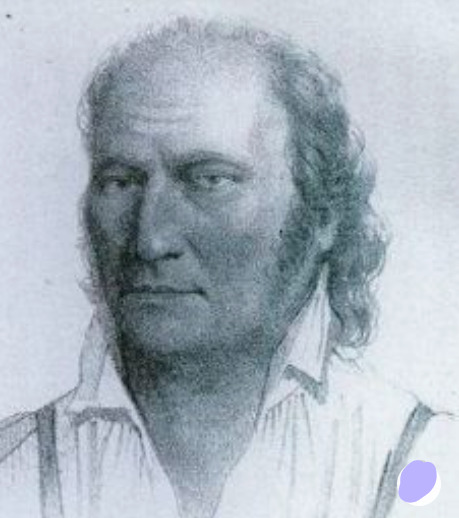
1725 – South Africa: Leendert Hasenbosch (c.1695–1725), a Dutch East India Company employee, is convicted of sodomy on a ship in Capetown. He’s left on Ascension Island as punishment and dies of thirst six months later. He kept a diary entitled Sodomy Punish’d which was published in 1726. In 2006 the full story was published by Alex Ritsema, with the support of Koolbergen’s family and publisher, in the book A Dutch Castaway on Ascension Island in 1725; a second, revised edition was printed in 2010.
1857 – Maine sets a one-year minimum for sodomy and eliminates the word "detestable" from the sodomy law.
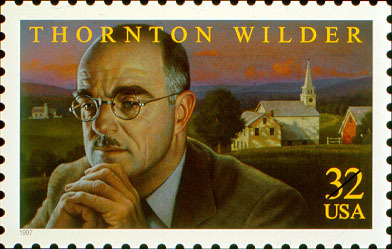
1897 – Born: Pulitzer Prize-winning American playwright and novelist Thornton Wilder (d.1975), a prolific writer prominent in twentieth-century literature. A discreet homosexual, his sexual proclivities were kept far out of the limelight. Wilder's mainstream literary works are landmarks of American literature, but they reveal scant traces of his homosexuality. He can be credited for acting as a behind-the-scenes ambassador for the Lost Generation, making their avant-garde themes accessible to a middle-brow American public.
Wilder was born in Wisconsin though he spent most of his boyhood in Berkeley, California. As an adolescent, Wilder isolated himself in academic projects. Wilder's entire family was one of achieving, industrious, self-reliant Congregationalists with a strong work ethic.His roving intellectual enthusiasms blossomed in his adolescence, especially his interest in theater. At fifteen the budding playwright was cast as Lady Bracknell in Oscar Wilde's The Importance of Being Earnest, but his strict father forbade this drag role. Later, Wilder delighted in playing central characters in his own plays, such as the Stage Manager in Our Town and Mr. Antrobus in The Skin of Our Teeth.
Wilder described himself as "The only writer of the Lost Generation who did not 'go' to Paris," a statement that was not literally true but which expresses his attachment to American life and values even as many of the writers of his generation yearned to escape what they saw as the stifling conformity of small-town life.
Wilder's warmest friendships included Gertrude Stein and Alice Toklas whom he met in Chicago in 1934. Through them he befriended many of the gay artists in their circle. For all the liberation of the Jazz Age and the period following, homosexuality was only discreetly discussed among writers of the Lost Generation.
Wilder seems to have been regarded even by his closest friends as a kind of Henry James figure, somewhat sheltered and cerebral, and frightened of sex. The relationship between Wilder and his one documented companion, Sam Steward, (aka Phil Andros) may have begun as a furtive sexual fling in Zurich in 1937. Steward, a writer, pornographer, tattoo artist, and one-time college professor, was, in pointed contrast to Wilder, open and adventurous. He wrote popular erotic gay works in the 1970s under the pseudonym Phil Andros. Wilder seems to have backed away from Steward after several awkward encounters. Intimate affection eventually became fond intellectual acquaintance.
Typical of some gay men of the era, Wilder preferred to play the role of the perennial Respectable Bachelor. Although he never publicly discussed his homosexuality, later in his life he is believed to have had discreet affairs with younger men. Despite his reticence concerning his sexuality, Wilder was a notably convivial man who enjoyed friendships with writers and actors and academics.
Wilder is the only writer to receive Pulitzer Prizes for both literature (The Bridge of San Luis Rey, 1927) and drama (Our Town, 1938; The Skin of Our Teeth, 1943).
During World War II, Wilder enlisted in the armed services, eventually becoming a Lieutenant Colonel in the Air Force. In the 1940s, Wilder also wrote the screenplay for Alfred Hitchcock's Shadow of a Doubt (1943).
After the war, he reworked an earlier play, The Merchant of Yonkers (1938), a comedy set in New York in the 1880s, that features the adventures of a neighborhood matchmaker, Dolly Levi, who eventually snares herself the perfect husband. It was not much of a success originally, but it became The Matchmaker (1955), a popular vehicle for Ruth Gordon, and it evolved into the even more popular Jerry Herman-Michael Stewart musical Hello, Dolly! (1964).
Thornton Wilder died on December 7, 1975. In Wilder's public and personal life, the "love that dared not speak its name" usually remained unspoken. One can only wonder whether he might have addressed more explicitly the question of homosexuality (and its repression) had he lived in a more tolerant time or place.

1919 – Chavela Vargas is a household name in Mexico but many North Americans aren’t privy to one of the most passionate performers of the last century. The queer masculine-presenting singer was prized for her tragic, tearful emoting — her songs appear in Pedro Almodovar films like Flower of My Secret.
A late bloomer, perhaps, but what a flower — Chavela Vargas did not release her first album until she was 42, didn't come out as a lesbian until she was 81, and didn't debut at Carnegie Hall until she was 83.
What was she doing all those years before recording Noche de Bohemia in 1961? Well, she dressed as a man, often in her signature red jorongo, smoked cigars, drank heavily, and packed a pistol, so obviously she was busy with more than singing rancheras in the streets. And maybe she had an affair with famed Mexican painter, Frida Kahlo (as Josephine Baker had).
Since that first record, she has released more than eighty albums. Her great fame of the 1960s and 70s subsided when she retired to battle her alcoholism. She returned to performing at 72 in 1991 in Mexico City. Since then her music has been widely used in films and she has appeared singing in several movies including Almodovar's Flower of My Secret, Julie Taymor's Frida, and Alejandro Innartu's Babel.
Buy her, beware: The first time you hear Chavela unleash her power midway through the quiet Paloma Negra you might drop whatever you're holding. She died in 2012 at 93.
youtube

Lindsay Anderson with Malcolm McDowell
1923 – Born: Film and stage director Lindsay Anderson (d.1994), a foundational figure in the "Free Cinema" movement of the 1950s, a group of British filmmakers who created low-scale realist works that focused on the ordinary or the socially marginalized, particularly the working class and the younger generation. A leader among such peers as Karel Reisz, Tony Richardson, Gavin Lambert, and John Schlesinger, Anderson was influential in shaping what now might well be considered the golden age of British cinema in the 1960s. Ironically, as a result of his independence and idealism, he directed relatively few major films, and both his professional and personal lives were affected by the repression and sublimation of his homosexuality.
Anderson was born in Bangalore, India, where his father was a captain in the British army. His family sent him to Cheltenham, an English private school, where he met his lifelong friend and colleague, Gavin Lambert, who like Anderson, was not only gay but would also enjoy a significant directorial career. Subsequently, Anderson attended Oxford University, where he specialized in Classics and later co-founded the film journal Sequence with Lambert. In his essays and reviews in Sequence and other journals, Anderson took aim against the conventions of contemporary British cinema, which tended to avoid controversy and favored the lives and loves of the upper middle class as its subject matter.
Anderson's first films were short semi-documentary studies, looking at the everyday activities of the lower classes. Yet while Anderson had paved the way for feature films about the lives of working-class individuals, such as those that Richardson, Reisz, and Schlesinger directed throughout the early 1960s, he left filmmaking in 1957, when he became a director at the Royal Court Theatre, London. In this capacity Anderson directed many major theatrical works, including the 1975 revival of Joe Orton's What the Butler Saw, the first unexpurgated performance of the play.
It was not until 1963, that he made his first feature film, This Sporting Life, which, in detailing the career of a young coal miner turned professional footballer, seemed to follow rather than lead then-current trends. As such, it was not a commercial success, yet it is significant inasmuch as its depiction of the frustration and the emotional and physical violence that characterize the lives of ostensibly heterosexual working-class men has an inescapable homoerotic undercurrent, as seen in the film's nude bathing scenes.
Many of these themes, although in a very different context, recur in Anderson's best known film, If... (1968). Set in a British private school--indeed, filmed at Cheltenham--the film explores the social fascism that is inculcated in such privileged institutions and ends with student rebels machine-gunning a school assembly. It is also noteworthy for its frank representation of homosexual relationships among the schoolboys.Although If... was well-received as a cinematic political statement in the zeitgeist of the late 1960s, Anderson's subsequent films, though often equally daring, fared less well. O Lucky Man! (1973), the second of a trilogy featuring the character Mick Travis, the protagonist of If... (played by Malcolm McDowell), is a rambling three-hour satire in the mode of Voltaire's Candide on the evils of military-industrial capitalism and scientific experimentation. Ambitious and idealistic, the film was nonetheless a commercial failure, and, as a result, Anderson had few offers or financial backers for subsequent film projects. The third film of the trilogy, the cult classic Britannia Hospital (1982), is a satire on the British national health service. During the 1970s and 1980s, Anderson continued to direct for the stage and directed a number of television plays.
On August 30, 1994, he died of a heart attack while in southern France. Despite Anderson's daring as a director, his recently published letters and Lambert's biography show a tormented man who struggled with his own sexuality. He tended to fall in love with his leading men, including Richard Harris, Albert Finney, and Malcolm McDowell, all of whom were heterosexual, married, and unattainable. His closest associates have speculated that his life was, for the most part, a celibate one. His films, in which homoerotic elements are often presented in a violent or disturbing manner, became the outlet for the desires he could not express in life.

1943 – Tommy Nutter (d.1992), was a British tailor, famous for reinventing the Savile Row suit in the 1960s.
Born in Barmouth, Nutter initially studied plumbing, and then architecture, but he abandoned both aged 19 to study tailoring at the Tailor and Cutter Academy.
In the early 1960s he joined traditional tailors Donaldson, Williamson & Ward. After seven years, in 1969, he joined up with Edward Sexton, to open Nutters of Savile Row at No 35a Savile Row. They were financially backed by Cilla Black and her husband Bobby Willis, Managing Director of the Beatles' Apple Corps Peter Brown, and lawyer James Vallance-White.
The business was an immediate success, as Nutter combined traditional tailoring skills with innovative design. He designed for the Hardy Amies range, and then for the man himself. His clients included his investors, plus Sir Roy Strong, Mick Jagger, Bianca Jagger and Elton John. Nutter himself was most proud of the fact that, for the cover of The Beatles' album Abbey Road in 1969, he dressed three out of the four: George Harrison elected to be photographed on the road-crossing in denims.
In the 1970s he branched out into ready to wear clothing, marketed through Austin Reed. In 1976 Sexton bought Nutter out of the Business. Sexton continued to run Nutters of Savile Row until 1983, when Nutter returned to the row with a ready to wear shop: "Tommy Nutter, Savile Row". (This new venture, which traded at No 19 Savile Row until Tommy's death, was backed by J&J Crombie Limited, who continue to own the "Tommy Nutter" trademark.)
In the 1980s, he described his suits as a "cross between the big-shouldered Miami Vice look and the authentic Savile Row." He created the clothing of The Joker worn by Jack Nicholson in the 1989 film Batman.
Nutter died in 1992 at the Cromwell Hospital in London of complications from AIDS.

1967 – About 150 people attended a public meeting in Wellington, New Zealand on 17 April 1967 to form a society to work for homosexual law reform. It called itself the Wolfenden Association, but it soon became the New Zealand Homosexual Law Reform Society. Lord Cobham, a former governor-general, was invited to become its patron. His letter to the society secretary, Jack Goodwin, declining patronage was blunt and expressed a common attitude:
'These people are mentally sick to as great an extent as, for example, people suffering from smallpox are sick. The whole problem of legalizing this offence seems to me to hinge upon the extent to which the disease is contagious.'

2013 – Marriage equality passes in the New Zealand Parliament 77-44.

14 notes
·
View notes
Text
The Pemberley College Yearbook: Volume III
It’s time to meet the freshers at De Bourgh University’s oldest and most prestigious establishment, including a new face (who might actually be quite familiar to some).
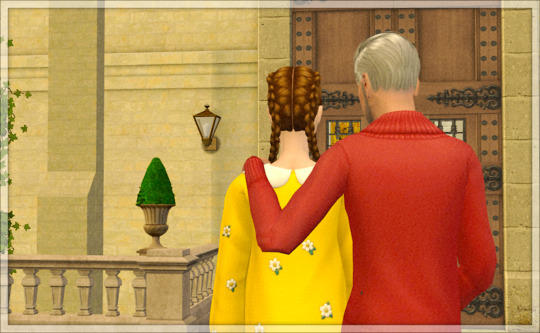

Of course it’s a very proud moment for George when he drops off daughter Isabella - if only her mother could have been here to see this day arrive!

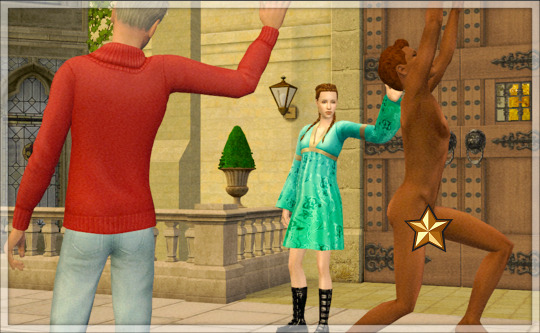

But like any caring parent, he can’t say that he doesn’t have his concerns about his daughter’s growing independence!
Isabella’s stats:
~ Scorpio 7 / 6 / 7 / 7 / 9
~ Coward / Kind / Neat / Natural Cook / Eco-friendly
~ OTH: Cuisine
~ Favourite Colour(s): Yellow
~ Aspiration: Family / Pleasure
~ Turn-ons / -off: +Tidy / +Charismatic / -Undead
~ Major: Art

The instant that her boyfriend Ambrose also arrives, she wastes absolutely no time in making her intentions clear! (Her moment of weakness with Elliot seems to be behind her.)

And Ambrose surprises me once again by saying yes without any hesitation!

I can see the appeal - he’s grown up to be quite a handsome chap.
~ Taurus 5 / 8 / 7 / 6 / 5
~ Easily Impressed / Dog Person / Supernatural Fan / Daredevil / Schmoozer
~ OTH: Sport
~ Favourite Colour(s): Red / Brown
~ Aspiration: Popularity / Romance
~ Turn-ons / -off: +Athletic / +Charismatic / -Indoorsy
~ Major: Art

Other relationships look like they are going to be a bit more... complicated. Daniel and Henrietta swiftly pick up from where they left off at home, but Daniel’s former sweetheart Clara seems to be taking it hard (even though she’s still also got a thing about his big brother Benjamin).
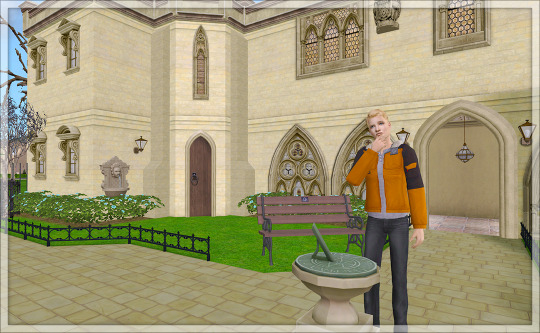
Daniel’s stats:
~ Pisces 5 / 6 / 9 / 9 / 10
~ Animal Lover / Kind / Over-emotional / Charismatic / Technophobe
~ OTH: Nature
~ Favourite Colour(s): Orange
~ Aspiration: Family / Popularity
~ Turn-ons / -off: +Animal Lover/ +Well-liked / -Undead
~ Major: Literature
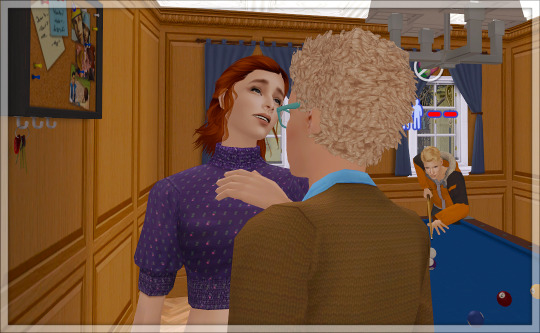
Daniel is unimpressed that Gabriel seems to be making a move on his girlfriend.
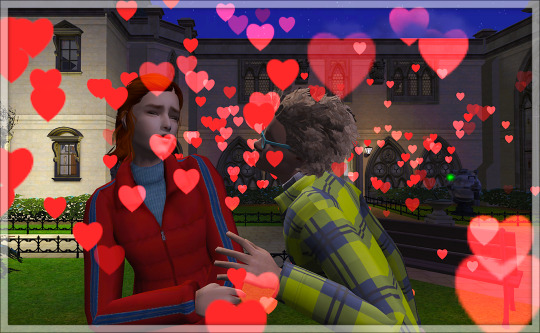
But while Henrietta is open to a bit of light-hearted flirting, she does not want to kiss him!
Gabriel’s stats:
~ Libra 6 / 4 / 6 / 7 / 5
~ Absent-minded / Eccentric / Good Sense of Humour / Easily Impressed / Ambitious
~ OTH: Games
~ Favourite Colour(s): Yellow / Blue / Turquoise
~ Aspiration: Pleasure / Popularity
~ Turn-ons / -off: +Charismatic / +Indoorsy / -Serious
~ Major: Drama (a perfect choice for him!)

Henrietta has some strong features - she takes after her dad - but I like her unique face.
~ Taurus 6 / 5 / 10 / 6 / 7
~ Coward / Hates the Outdoors / Supernatural Fan / Charismatic / Lucky
~ OTH: Music & Dance
~ Favourite Colour(s): Red
~ Aspiration: Fortune / Popularity
~ Turn-ons / -off: +Cultured / +Well-liked / -Plant Lover
~ Major: Economics

New-found freedom means party time!

Esther is also new to the College this year, but she’s been taking time to get settled into academic life, before throwing herself into the social scene.
Aries 6 / 7 / 6 / 4 / 6
~ Heavy Sleeper / Disciplined / Handy / Workaholic / Loves the Cold
~ OTH: Tinkering
~ Favourite Colour(s): Red
~ Aspiration: Family / Fortune
~ Turn-ons / -off: +Serious / +Tidy / -Unique
~ Major: Literature

There’s also someone who is not only new to the University, but new to the planet too! Green Bean (by @moocha-muses) is a half-alien who was raised in mysterious circumstances in a lab on Sixam, but he showed significant academic promise and so was granted sponsorship to study on Planet Sim.
Libra 2 / 8 / 4 / 8 / 10
~ Cat Person / Adventurous / Inappropriate / Avant Garde / Loves the Outdoors
(He would never wish to cause offence, but his unusual background means that he is rather ignorant of Sim etiquette and has some quite unconventional ideas; and he just thinks cats are really cute.)
~ OTH: Cuisine
~ Favourite Colour(s): Pink / Turquoise
~ Aspiration: Family / Popularity
~ Turn-ons / -off: +Foodie / +Well-liked / -Undead
~ Major: Literature (he believes that the best way to understand the culture of his new home planet is to study its creative works)

He’s a very curious soul, keen to explore his Sim heritage and experience everything that this new world has to offer, especially - after a lifetime of lab-processed nutritional supplements - the food (and beverages)!

He’s also very friendly and good-natured, and loves meeting new people! But most of all - given his rather clinical upbringing - he longs one day to be part of a real family.


Oh no, not you too, Green Bean!
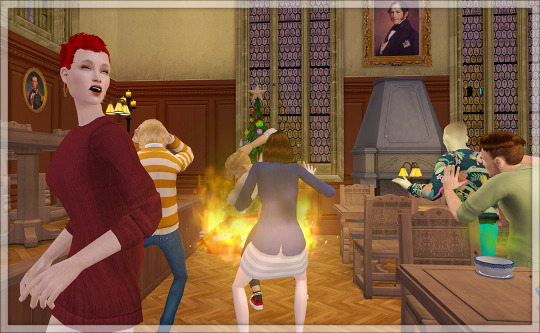
Since it’s Winterfest-time, the College decorates the Refectory with a festive tree, but it brings the partying to an abrupt halt by catching fire! (I didn’t know they did that, what a nuisance!)

And all this time, our final new student, Joanna, has been keeping to herself - just as she always does.
~ Sagittarius 8 / 2 / 6 / 3 / 6
~ Bookworm / Never Nude / Workaholic / Brooding / Unflirty
~ OTH: Film & Literature
~ Favourite Colour(s): Orange
~ Aspiration: Knowledge / Fortune
~ Turn-ons / -off: +Cultured / +Reserved / -Rebellious
~ Major: Mathematics (her first love is Literature, but being a supremely practical girl, she knows that studying Mathematics will give her more options)
#sims 2#gameplay#merybury#de bourgh university#isabella knightley#ambrose elton#daniel bingley#henrietta wentworth#gabriel smith#esther dashwood#green bean#joanna brandon#clara dashwood#pemberley college
25 notes
·
View notes
Text
The Vibrant Student Life in Munich

Munich, a city synonymous with cultural richness and historical allure, stands as a beacon for students seeking an exceptional academic and social experience. Embark on a journey with us as we explore the vibrant tapestry that is student life in Munich, where tradition seamlessly intertwines with modernity, offering an unparalleled environment for growth, learning, and making memories.
Also Read: study in germany consultants
Academic Excellence: Munich's Educational Hub
Munich's academic landscape is a testament to its commitment to excellence. Home to globally renowned institutions such as Ludwig Maximilian University and the Technical University of Munich, the city provides a diverse range of academic programs. From cutting-edge research facilities to innovative teaching methodologies, Munich's universities foster an environment that challenges and nurtures intellectual curiosity.
Also Read: study abroad consultants in coimbatore
Cultural Fusion: Beyond the Lecture Halls
Beyond the academic realm, Munich unfolds as a city where culture pulsates through its veins. Students are not mere spectators; they are active participants in the city's cultural scene. Museums, galleries, and theaters dot the city, offering a plethora of opportunities to indulge in artistic expressions from classical to avant-garde.
Also Read: overseas education consultants in madurai
Oktoberfest Extravaganza: A Social Affair
One cannot talk about Munich without mentioning the world-famous Oktoberfest. The annual extravaganza transcends the boundaries of a traditional beer festival, transforming into a cultural celebration that unites students and locals alike. Immerse yourself in the lively atmosphere, indulge in traditional Bavarian delicacies, and create lasting memories with fellow students from around the globe.
Also Read: study abroad consultants in trichy
Accommodation: A Home Away from Home
Finding the right accommodation is crucial for any student's well-being. Munich offers a plethora of options, from cozy student dormitories to shared apartments. Navigate through the housing landscape effortlessly, ensuring that your living situation complements your academic journey, providing a secure and supportive environment.
Also Read: study in germany consultants in Vellore
Recreation and Nature: Balancing Student Life
Amidst the hustle and bustle of academic life, Munich generously provides spaces for relaxation and rejuvenation. The English Garden, one of the world's largest urban parks, invites students to unwind amidst nature's embrace. Escape the academic rigor, take a stroll along the serene Isar River, or indulge in sports and recreation – Munich offers a perfect balance for the diligent student.
Also Read: Cost of Living in Germany for Indian Students
Biking Adventures: Exploring Munich's Beauty
Munich's bike-friendly infrastructure opens avenues for students to explore the city intimately. Pedal through historic streets, discover hidden gems, and create a unique connection with the city that goes beyond textbooks and lectures. Biking becomes not just a mode of transport but a delightful exploration of Munich's picturesque landscapes.
Also Read: Masters in Robotics in Germany
The Culinary Expedition: Gastronomic Delights
No student experience is complete without delving into the local culinary scene. Munich, with its diverse gastronomic offerings, caters to every palate. From traditional Bavarian delights like pretzels and sausages to international cuisines, students can embark on a gastronomic expedition that mirrors the diversity of the academic experience.
Also Read: Masters in Cybersecurity in Germany
Networking Opportunities: Building Future Connections
Munich's student life extends beyond academic corridors, providing ample opportunities for networking and building lasting connections. Attend industry events, engage in internships, and participate in student clubs – lay the foundation for your professional network while still pursuing your education.
Also Read: Masters in Artificial Intelligence in Germany
Conclusion: Munich's Student Life Unveiled
In conclusion, Munich stands not just as a city of academic excellence but as a haven for students seeking a holistic experience. The fusion of tradition and modernity, the cultural vibrancy, and the plethora of recreational opportunities make Munich an ideal destination for those yearning for a vibrant student life. Embark on this journey with us, and let Munich be the canvas upon which you paint your academic and personal masterpiece.
0 notes
Text
Elevate Your Future with Cutting-Edge Overseas Education Consultant
Unleash global possibilities with our avant-garde overseas education consultant. From bespoke guidance to streamlined admissions, dive into a realm of limitless academic adventures. Click now to redefine your educational journey!

0 notes
Text
Elevate Your Future with Cutting-Edge Overseas Education Consultant
Unleash global possibilities with our avant-garde overseas education consultant. From bespoke guidance to streamlined admissions, dive into a realm of limitless academic adventures. Click now to redefine your educational journey!

0 notes
Text
Unleashing Brilliance: Navigating Best Management Colleges in Delhi
Craving a dash of excellence in your educational journey? Look no further, because Delhi, the heart of India, boasts some of the finest management colleges that can turn your academic dreams into reality.
1. Delhi Dreams: The Quest for the Best
You’ve made the decision to immerse yourself in the fascinating field of management studies in Delhi, a busy metropolis. Well done! But how do you choose the best option for you when you have so many options available to you? Do not be alarmed, adventurous student, for we are going to set out on a quest to discover the essence of awareness.
2. BBA Bliss: Crafting Future Business Leaders
Picture this: You, clad in the robe of knowledge, walking the hallowed halls of the best BBA college in Delhi. Sounds like a dream, right? Well, dreams do come true, my friend. Delhi’s top-notch BBA institutions are not just about textbooks and lectures; they’re about molding raw potential into business-savvy trailblazers.

In the vibrant landscape of Delhi, these BBA colleges stand out like beacons of educational brilliance, offering a blend of theoretical wisdom and practical insights. From case studies that mimic real-world scenarios to internships that thrust you into the corporate jungle, these institutions ensure you’re well-equipped to face the challenges of the business world.
3. MBA Marvels: Nurturing Future CEOs
Fast forward a few years. You’ve aced your BBA, and now the world of MBA beckons. Delhi, with its finger on the pulse of global business trends, houses some of the best MBA colleges in India. These temples of higher learning aren’t just about degrees; they’re about sculpting visionaries, innovators, and future CEOs.
Envision a curriculum that seamlessly blends traditional business theories with the avant-garde strategies shaping the corporate landscape. That’s what these MBA colleges in Delhi bring to the table. Case in point: you could find yourself in a classroom discussing the latest market trends in the morning and engaging in a live project with industry leaders in the afternoon.
4. Beyond the Books: What Sets Them Apart
Now, let’s address the million-dollar question: What sets the best management colleges in Delhi apart from the rest of the academic herd? It’s not just about the classrooms or the sprawling campuses; it’s about the holistic experience they offer.

These institutions understand that education isn’t a one-size-fits-all affair. They tailor their approach to cater to different learning styles, ensuring that every student gets the chance to shine. Whether you’re a fervent debater or a quiet thinker, there’s a place for you in these colleges.
Moreover, the faculty isn’t just a bunch of professors; they’re mentors, guides, and sometimes, even friends. They go beyond the prescribed syllabus, helping you connect the dots between theory and practice. It’s this personalized touch that transforms education from a mundane routine to an exhilarating journey.
5. Decoding the Best: Tips for Aspiring Scholars
So, you’re ready to take the plunge into the world of management education in Delhi. Here are some quick tips to help you navigate this exciting journey:
— Explore Beyond Rankings: While rankings provide a broad overview, don’t forget to delve into the specifics. Look at the faculty, the course structure, and alumni success stories to gauge the true essence of a college.
— Attend Open Houses: Take advantage of open house sessions to interact with current students and faculty. It’s a golden opportunity to get an insider’s perspective and understand the culture of the institution.
— Follow Your Passion: Choose a college that aligns with your career aspirations and personal interests. If you’re passionate about marketing, for instance, opt for a college renowned for its marketing curriculum and industry connections.
In conclusion, best management college in Delhi aren’t just academic institutions; they’re crucibles of transformation. Whether you’re aiming for a BBA or MBA, these institutions have the magic formula to turn your aspirations into achievements. So, gear up for an extraordinary academic journey in the heart of India, where education is not just a destination but a thrilling expedition.
#Best Management College in Delhi#Best BBA College in Delhi#Best MBA College in India#MBA College in Delhi#Best Management Colleges in Delhi#MBA Colleges in Delhi#Best BBA Colleges in Delhi
0 notes
Text
Modes of Expression and Reflection
VIVA HUMANITIES!: EMBRACE YOUR INNER SCHOLAR
MODES OF EXPRESSION:
( Philip Bishop, Adventures in the Human Spirit)
ARTS:
Pictures/images/Paintings/Photographs
Sculpture
Literature (arts made of words)
Epic
Narrative/Story
Novel
Stories/Short Stories
Poetry (narrative, lyric, drama)
Music
Dance: Dance Floor Culture/Folk/ Ballet/choreographed/performance
Architecture
Drama/theatre
Film
**********************************************************
MODES OF REFLECTION
(also from Bishop)
Ways of thinking:
History (what happened, when did it happen why did it happen (causes), consequences, how do we know it happened d what are the debates about the event, how do we interpret the meaning of the event?)
The meaning of history: history as the ongoing process of the unfolding of unique events in time.
Archaeology (extracting and interpreting material culture that human beings leave behind)
Philosophy
Comparative Religion
Ninian Smart, The Religious History of Mankind
beliefs
rituals
ethic and behaviors(to do and not to do)
narratives
social experience (the members in groups)
personal experience (what does it feel like to be a Lutheran?)
arts
Human Culture: innovations and developments:
Language/ Mathematics/ Science/Justice systems/religious rituals/governance, concepts/idea have histories, etc., and others
Academic institutions may include media studies (film history, etc) or Cultural Studies as Humanities fields (Black or Gender Studies, Native American Studies, etc.)
Professions: all professions have a history (for example, nursing)
***
In my Humanities course at United Tribes Technical College I told the class that we would incorporate experiences with these four kinds of cultural categories: We would share experiences with these three cultural categories.
-classical
-contemporary arts (avant-gardism, modernist experimentation)
-indigenous, traditional and contemporary
-popular culture
***
YOUR PERSONAL HUMANITIES INVENTORY
Modes of Reflection:
A historical event that that you would like to know and learn more about.
Year of your birth____________. An event of consequence occurring in the year of your birth.
A religious symbol: name a religious symbol that intrigues you.
What sacred text of a religion do you feel that you know best?
An archaeological enterprise:(an archaeological topic or project that drew or draws your attention.
Philosophy: name a philosopher who has drawn your attention.
Give one idea, concept, or topic associated with this philosopher.
Modes of Expression A work of art: experience, think about, talk about (discuss) interpret, study, search, research, present about (write or speak)
1.Reflect on the actual sculptures installed in public space in your community. Choose one that you like.
2..Name one famous picture (painting, drawing, photograph) that has made an impact on you.
4.Your experience with an ancient epic.
5.One poem that you think about frequently.
6.A novel you read in school that sticks with you.
7. Music: describe your early experience of an important piece of music
8. Your response when your hear the word “dance.”
Your experience as a dancer.
Consider three dance modes:
-ballroom/dance floor culture
- folk, this could include indigenous dance forms
- performance dance, concert dance/ ballet
9.Architecture: one of the most impressive buildings, structures, public space in your community.
10. Three of the most influential movies of your life.
11.Your experience performing in a live drama/play. A recent experience of attending a live performance of a play. Who were the performers?
10. Take Away Time. Personal reflections after completing this process and discussing it with the class participants: a thought and a question.
11.MONTAIGNE EXPERIENCE TIME: LEARNING FROM YOUR UNIQUE LIFE EXPERIENCE. Make a list of various life-time experiences, reflect on these experiences. Suggestion: choose experiences that occurred over a period of time, rather a “one time thing.” Choose one to focus on. Ask the question:: WHAT HAVE I LEARNED FROM HAVING THIS EXPERIENCE? Socratic questions: Who am I, having had this experience? How can I examine my life know that I have had this experience? Montaigne question: What have I learned from this experience, about myself, about life in a culture and in history, and about life itself.
IN THE OPEN AND ENTHUSIASTIC SPIRIT OF PHILOSOPHER MICHEL DE MONTAIGNE AND DRAWING ON THE VAST WEALTH OF CULTURAL RESOURCES AVAILABLE TO ME I AM ASKING THE QUESTION WHAT HAVE I LEARNED ABOUT LIFE ITSELF FROM MY EXPERIENCE WITH ------------------------------------------.
Some options to draw on:
-Conversations
- Journal writing and creativity
-Poem or Poems
-Write essay
1 note
·
View note
Text
30th Anniversary Bounce Trumpet Awards Honoring Black Excellence to World Premiere on Juneteenth at 6pm CT

Bounce, the nation’s popular entertainment television network serving African Americans, will present the 30th Anniversary Bounce Trumpet Awards -- a night of inspiration, history, and crowd-rousing performances celebrating African American achievements and contributions on Juneteenth, Sunday, June 19 at 6 p.m. CT.
The 2022 Bounce Trumpet Awards will honor:
· Courtney B. Vance (Excellence in Entertainment Award): Vance’s debut in “Hamburger Hill” launched a prolific cinematic career that includes “The Hunt for Red October,” “The Preacher’s Wife,” and “The Adventures of Huck Finn.” His work in television includes “The People vs. OJ Simpson: American Crime Story,” for which he won an Emmy, Critics Choice, and NAACP Image award.
· Stan Lathan (Living Legend Award): Lathan launched HBO's groundbreaking “Def Comedy Jam,” produced and directed comedy specials featuring Dave Chapelle, Cedric The Entertainer, and much more in his storied career.

Zaila Avant-Garde. Source Facebook @zaila.avantgarde
· Zaila Avant-Garde (Rising Star Award): The Louisiana native was the 2021 Scripps National Spelling Bee winner and the first Black American to win the academic competition. She also holds three basketball-related Guinness World Records.
· Raphael Warnock and Jon Ossoff (Xernona Clayton Award of Distinction): The senators from Georgia will be honored with this award, named after the founder of the Trumpet Awards, for succeeding against immense odds, fighting for change and working to improve the lives of all. Warnock has served as senior pastor at Ebenezer Baptist Church in Atlanta for over 15 years (the former pulpit of Rev. Dr. Martin Luther King, Jr.). Ossoff was mentored by civil rights legend and former Trumpet Award honoree Congressman John Lewis.
· Princess Sarah Culberson (Impact Award): This award is given for demonstrating tremendous vision, leadership, and innovation that has led to a positive impact on the community. Culberson and her brother founded the non-profit Sierra Leone Rising, which distributed aid during the 2014 Ebola outbreak and the 2020’s COVID-19 crisis and continues to raise funds for community growth.
Among the special guests paying tribute to this year’s honorees are Wendell Pierce, Sanaa Lathan, JB Smoove, and Tamron Hall. Musical performers include Mary Mary, Tank, PJ Morton, Avery Wilson, and more. The special was produced by Magic Lemonade Production Company.
"It's fitting that we will honor Black excellence and achievement on a day that is a commemoration of such a significant moment in our history as African Americans," said Cheryle Harrison, head of Bounce. "We appreciate everyone's patience in our having to adjust this year's schedule. Health and safety are a priority for our guests, honorees, and staff."
About Bounce
Bounce (@bouncetv) programming is seen over the air, on cable, on DISH channel 359, over the top on Roku®, on mobile devices via the Bounce and Brown Sugar apps, and on the web via BounceTV.com. Bounce features a programming mix of original series, docuseries and movies, off-network series, theatrical motion pictures, specials, live sports and events and more. Bounce is part of The E.W. Scripps Company (NASDAQ: SSP).
# # #
#TV#Television#Bounce TV#Wendell Pierce#Sanaa Lathan#JB Smoove#Tamron Hall#Mary Mary#Tank#PJ Morton#Avery Wilson#Magic Lemonade Production Company#Cheryle Harrison#Trumpet Awards#Courtney B. Vance#Stan Lathan#Zaila Avant-Garde#Raphael Warnock#Jon Ossoff#Princess Sarah Culberson#naomi j richard#naomijrichard#Naomi Richard#RCV#Red Carpet View#KAZI 88.7#KAZI 88.7FM#2022 Bounce Trumpet Awards#Bounce Trumpet Awards
0 notes
Photo

Half of what makes being a professor fun is wearing eccentric outfits and looking absolutely gay (affectionate) in them.
#personal#actually me#real life Dr. Hyde (without the crime)#do not reblog#likes encouraged!#professors of tumblr#I may be an adjunct but being called Professor [Avant] is super neat#avant's adventures in academe
7 notes
·
View notes
Audio
VA - Anthology Of Experimental Music From Japan (Unexplained Sounds Group)
Modern-day noise music has escaped the preserve of academics and avant-garde thinkers, uniting conservatory-trained and untutored participants from the worlds of punk, jazz, metal, contemporary classical, electronic music, and sound art in an exuberant and egalitarian collision. While noise conjures up the image of a cacophonous maelstrom of sound, contemporary improvisers utilize a much broader tonal palate, often offsetting abrasive textures with environmental sound, field recordings, and even silence. This is especially true in Japan, which has become a global center for the genre. Artists including Haino Keiji, Merzbow, Ōtomo Yoshihide, and Hijōkaidan rank among the scene’s most respected and influential names. So synonymous, in fact, is the country with this style of music that the term “Japanoise” was coined to provide a convenient catch-all. Some of the elements of traditional Japanese music seem to a novice like mere “noise” and have clear parallels in modern experimental music: a relative absence of harmony; the dissonant tonal clusters produced by banks of shō mouth organs in the court music called gagaku; the spluttering, wheezing, trills and flutter-tonguing of the shakuhachi; the stop-start rhythms, droning, repetitive vocals, and shrill, unmelodious flute of nō and kyōgen drama; the strident, uartertone jōruri narration and plink-plonk samisen that accompany bunraku puppet theater; and the gaping silences and austere arpeggios plucked out on traditional string instruments like the koto and biwa. No wonder a music coming from the merging of such tradition with new music developments from the West had to take its direction to something “other”.
David McMahon
This anthology of experimental music from Japan showcases the young generation of musicians alongside established names and provides an insight into the current experimental scene, confirming the adventurous character of the Japanese music research.
Edited by ©Unexplained Sounds Group
Co-curated by Raffaele Pezzella and Farabi Toshiyuki Suzuki
Cover image: “Fine Wind, Clear Morning” by Katsushika Hokusai
#various artists#compilation#unexplained sounds group#japan#experimental#electronic#avant-garde#2022
10 notes
·
View notes
Text
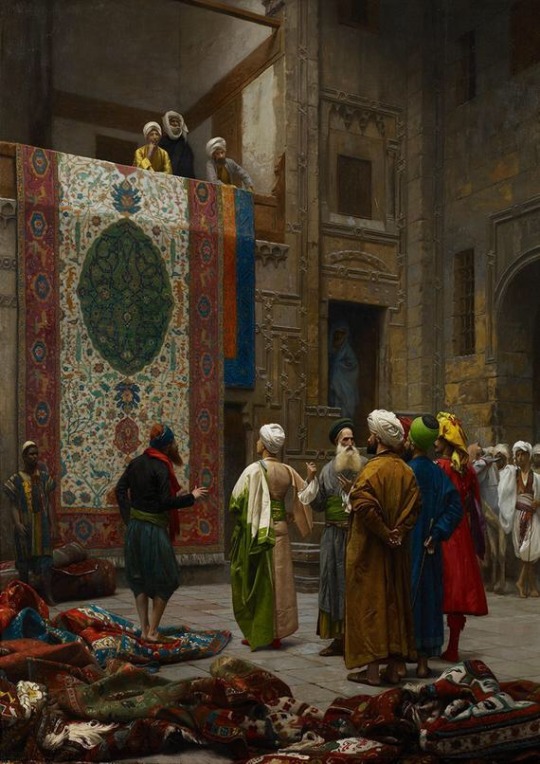
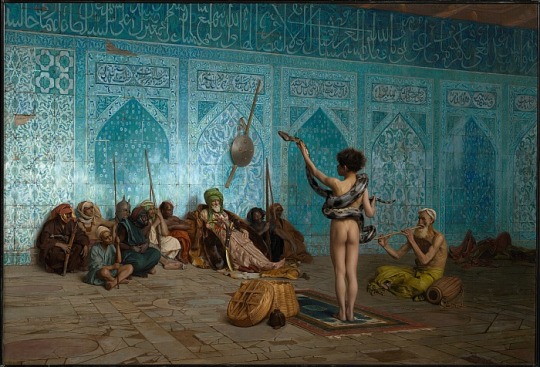
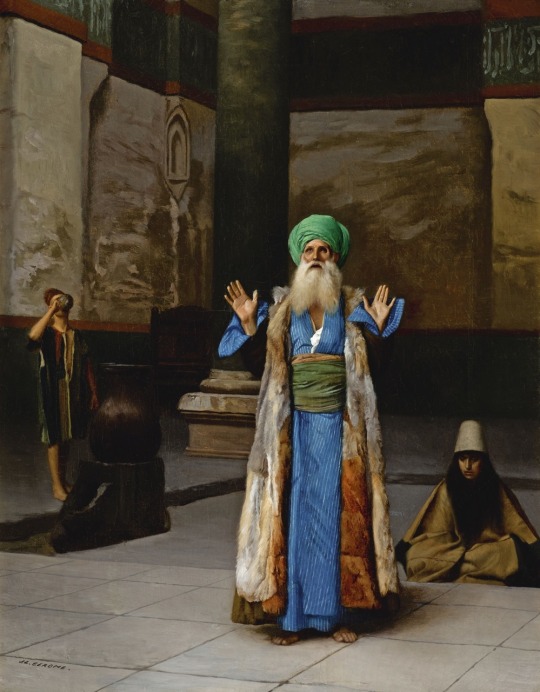





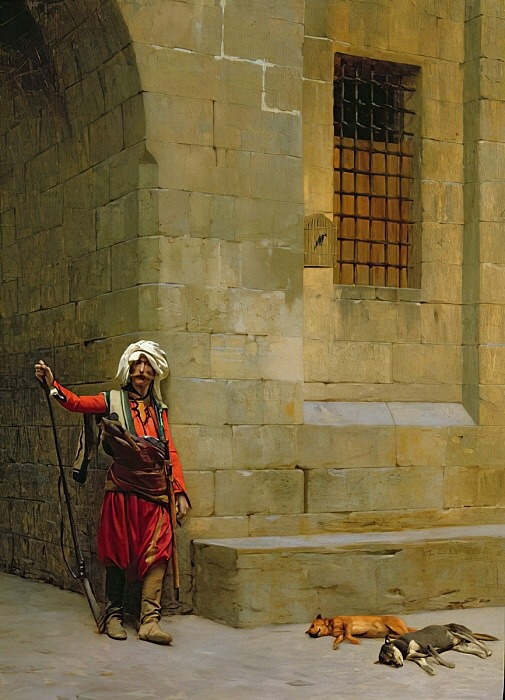

ORIENTALISM
After decades of disinterest and contempt, Orientalist art, and the art of Jean-Léon Gérôme in particular, is once again in demand among collectors and fetching high prices at auction. Both Sotheby's and Christie's have Departments of Orientalist art, with Sotheby's proclaiming its "proud history of selling exceptional Orientalist paintings at auction" and Christie's "demonstrating the timeless appeal of this aesthetic." The April 2019 Sotheby's Orientalist auction totaled £5.4 million; Christie's sold Gérôme's portrait of Markos Botsaris (seen above) for $3.3 million in the same month.
Within the academy, however, Gérôme's standing in the western canon has yet to recover from the publication of Edward Said’s Orientalism in 1978. Although Said never discusses the visual arts, his influential critique of western colonialist and imperialist representations of the “oriental” other is easily and profitably applied to Gérôme’s pictures of life in the Arab and Muslim worlds (the book’s cover illustration is by Gérôme). Gérôme’s vast œuvre, in many ways, sustains such a critique. Considered an expert on Near Eastern culture by Napoléon III, a member of the Légion d’Honneur, an academician of the Institut de France, the President of the Société des Peintres Orientalistes Français, and as a popular and regular exhibitor of orientalist painting at the salons, Gérôme had a greater influence on French conceptions of Near Eastern culture and official policies on colonial affairs than most artists had on any area of society.
Neo-classical history painting employed monumental scale and meticulous facture to depict edifying episodes of ancient history with grandeur and clarity. Like most mid-century academic painters, Gérôme retains the large format and high-gloss finish, but takes a novelistic, rather than exemplary, approach to his subject matter.
His painstakingly detailed images of mosques, markets and hamams that serve as settings for his orientalist pictures were based on copious oil sketches made and feature artifacts acquired over numerous trips to the eastern Mediterranean. Taken together, the details gives the impression of obsessive, empirical observation—a realism intended to reassure the viewer of the authenticity of the picture‘s content.
What one sees, however, is, for the most part, anecdotal depictions of unheroic, daily life. The mundane ativities depicted—arguments, daily prayers, playing with pets, casual conversations—recall genre painting and do not provide models of virtuous behaviour. Instead, these accessible, familiar scenes of everyday life invite the viewer to identify, to a certain extent, with an alien culture. Like Alma-Tadema’s Victorianized Romans, Gérôme encourages us to see ourselves in the oriental other. The colony is a reflection of imperial overlord.
The implied transcultural humanity suggested by Gérôme’s choice of relatable subjects should not, however, be overstated. The depictions of the unheroic persons insufficiently engaged in unimportant activities is part of larger denunciation of “oriental” culture in general. Gérome paints scene after scene of idleness, lassitude, and inertia—men lean against buildings, sit stupified with a hookah, squabble in the streets, dogs sleep in the sun, and limp women loll around the baths while mosques crumble in the background.
The overwhelming sense of stagnation, of a falling off from past greatness and achievement, that pervades the Near East of Gérôme’s pictures is best expressed by a picture a group of travelling merchants and their camels resting in heaps at the feet of a colossal, still erect, statue of an Egyptian pharaoh. The backwards, indolent nature of the contemporary oriental other is, of course, a primary justification for western colonialism. “The white man’s burden,” as Rudyard Kipling memorably put it, involves the imposition of western improvements and notions of progress on the benighted subaltern.
Sexual malaise goes hand in glove with stagnation in the orientalist imaginary. Gérôme’s more lurid works (like The Snake Charmer) and the images of the harem and slave market rely on a queasy eroticism and to shock, disgust, but also titillate, their western audiences. While it is difficult to determine if Gérôme is aware of the degree to which these pictures reflect anxieties about 19th-century French sexual mores, it is very clear that they reflect popular and official views and opinions about the inhabitants of the colonies.
The technical virtuosity on display in Gérôme’s paintings is astonishing, but no amount of bravura can detoxify his orientalist ideology. The apparent lack of self-awareness concerning painting’s role in the construction of that ideology is one of the criteria that, in general, distinguished academic artists from the Impressionist avant garde, whom Gérôme detested. To be sure, he condemned Manet and Monet on formal, not ideological, grounds, but that actually gets to the heart of the matter. Manet attempted to depict the realities of the French colonial adventure in the Execution of Maximilien but found the subject too appalling to bring to compositional completion. Gérôme's art, by contrast, is characterized by its high degree of finish no matter how meretricious the subject.
#orientalism#imperialism#colonialism#jesn-léon gérôme#academic art#french painting - 19thc.#second empire
17 notes
·
View notes
Text
Experimental Film
VIVIAN OSTROVSKY - PLUNGE
16 films by Vivian Ostrovsky made between 1982 and 2014.
"An intimate - yet humorous - act of cultural resistance, the cinema of Vivian Ostrovsky is a gesture, implying the filmmaker's entire body - as she travels around the world, carrying the gear, framing with a camera-eye. She digs in archival footage for an immense repertory of cinematic gestures performed by others - and playfully edits them with her own Super-8 shots. Multi-culturalism and polyglotism are woven into this poetics of displacement." - Berenice Reynaud
2 DVDs (With Subtitles Subtitles) / 2019 / 215 minutes
MARIE LOSIER - HELLO HAPPINESS!
10 short films by Marie Losier.
French-born New York filmmaker Marie Losier learned the 16mm Bolex camera from George and Mike Kuchar and made a series of "Dream Portraits" of New York filmmakers, theatre, music and performance artists.
Marie Losier is the most effervescent and psychologically accurate portrait artist working in film today. Her films wriggle with the energy and sweetness of a broken barrel full o' sugar worms!!! No one makes pictures like Marie, Edith Sitwell's inner Tinkerbell!!! - Guy Maddin
Marie Losier's movies are as sweet and sassy as her name and well worth a gander or goose by all off beat cineastes. So beat off to a different drum and marvel at the wad of wonders that only a French woman could generate. Take a trip down a sprocketed spiral of celluloid strips into a glory hole of impressive dimensions. What pops through will surely enlarge with persistent, ocular manipulation. - George Kuchar
SELECTED SHORTS IN 16 MM:
L'Oiseau de la Nuit 20', 2016
Bim, Bam, Boom, las Luchas Morenas! 13', 2014
Alan Vega, Just a Million Dreams 16', 2014
Byun, Objet Trouve 7', 2012
Slap the Gondola! 15', 2010
Manuelle Labour 10', 2007
Eat My Make-up! 6', 2005
Electrocute Your Stars 8', 2004
Bird Bath and Beyond 13', 2003
The Ontological Cowboy 16', 2005
DVD (With French Subtitles) / 2016 / 124 minutes
SANDY DING - PSYCHOECHO
By Sandy Ding
Sandy Ding is an experimental filmmaker who lives and works in Beijing, China. He graduated from CalArts Film School USA in 2007 and started teaching in China Central Academy of Fine Arts since 2008. He produced several psycho-active films with the idea of combining ritual process in projection and sound. His work is energy patterns, telling mysteries with abstractions or powerful symbolic elements. He is equally interested in live performance of theater projections, untypical gallery projections, installations and live noise music to extend the idea of experimental film.
FILMS
Mancoon 10 min, 16mm, silent, color, 2007
Water Spell 42min, 16mm, color, 2006-2007
Prisms 20 min, 16mm, color, 2012
Dream Enclosure 18 min, 16mm/Digital, b/w, 2011-2014
The Radio Wave Beneath the Dirt Ice and Flowers 10 min, 35mm, silent, b/w, 2006
BONUS
River in the Castle 4 min, 16mm, silent, b/w, 2016
Original noise music: "Peacock and Ocean Erosion" by Liquid Palace 28 min, 2016.
DVD / 2016 / 132 minutes
STUDIO EEN: EXPERIMENTAL FILMS FROM THE LOWLANDS
a collection of 12 films from the Dutch film cooperative Studio Een
In 1990, as a student, Karel Doing decided to create Studio een. Many artistic, avant-garde, underground movements and counterculture movements seemed to be over. The rise of video and its academic use began to compete with Super8. To work against the decline of the Super 8 format and techniques, Karel Doing and two of his friends (Saskia Fransen and Djana Mileta) from the art school in Arnham, started to think about creating a new space and promoting the invention of DIY techniques for filming and processing Super8 films.
In this particular context, Studio een was launched. Conceived as a actual workspace, Karel Doing, Djana Mileta and Saskia Fransen, began by establishing it within a large network of festivals, galleries and other workspaces. They bought optical printers from a professional laboratory that was set to shut down and started to learn by themselves, out of necessity, how to process film. It wasn't long before Studio een became well-known in DIY film circles and began to host various artists who come to meet each other, not only to exchange ideas and work together on the use of Super8 or 16mm, but also to experiment with diverse narrative and sound forms. Some members, Joost Rekveld for example, chose to pursue a career as a musician as well as a filmmaker.
After 7 years in Arnhem, Studio een moved to Rotterdam where it continued to thrive. It became a model for many artists in creating their own laboratories, research centers and studios dedicated to experimental cinema.
Studio een no longer exists, but the laboratory itself continues in Rotterdam under the name of Filmwerkplaats by being involved in new experimentations in filmic creation while promoting the works of members and invited artists.
This DVD edition includes works of various Dutch artists who had a main role in the early years of Studio een, from 1992 to 1996.
DVD-9 (Black and White, With Booklet) / 2016 / 114 minutes
MY SEVEN PLACES
By Boris Lehman
My Seven places' starts at the moment I was evicted from several places which are dear to me. They served me well as homes, both as place for living and working. This was the start of my urban wandering, which would take me ten years - a journey of 300.000 kilometers - before returning just about to my starting point. The adventure was both physical and metaphysical. Fragments of documentary films, a personal diary, bedside-table notes, piece of fiction, 'My Seven places' is an essay about passing time, embellished by a jumble of reflections both light and serious; finally, it is an attempt to simply exist. The fourth episode of my autobiographical fiction, which started in 1983
2 DVDs (French, With English Subtitles) / 2015 / 323 minutes
CINEXPERIMENTAUX 10: CHRISTOPHE KARABACHE
A documentary on the Lebanese experimental filmmaker Christophe Karabache by Frederique Devaux and Michel Armager.
Christophe Karabache is an independent French-Lebanese filmmaker born in Beirut in 1979. In 2000, he began exploring various film formats at l'Etna, an alternative workshop in Paris. He shifts between documentary and fiction formats, bringing to mind the wounds of Lebanese society, displaced beings, the fragmentation of identity. Pulsating scenes and jolting cuts demonstrate his desire to destroy cliches. The shock of the imagery in his feature-length films, made after 2010, bears witness to a penetrating critical eye on Lebanon's cultural shifts and the rupture of meaning.
DVD (French, With English, French Subtitles) / 2012 / 74 minutes
LA CICATRICE INTERIEURE
La Cicatrice interieure of Philippe Garrel, 60', 1972
with: Nico, Philippe Garrel, Pierre Clementi, Christian Paffgen, Daniel Pommereulle, Balthazar Clementi, Jean-Pierre Kalfon
DVD (French, With English, French, Japanese Subtitles) / 1972 / 60 minutes
MARCEL HANOUN - OCTOBRE A MADRID
By Marcel Hanou
DVD (French, With English Subtitles) / 1964 / 63 minutes
MAURICE LEMAITRE - LE FILM EST DEJA COMMENCE?
LE FILM EST DEJA COMMENCE? (62 mins, 1951, 16mm) Digital Restoration master made by Light Cone and the CNC.
PORTRAIT OF MAURICE LEMAiTRE by Pip Chodorov (2004, 15 min, 16mm/DV)
DVD (French, With English, French Subtitles) / 1951 / 77 minutes
7 FILMS BY BORIS LEHMAN
With 7 short films by Boris Lehman
Selection of 7 films by Boris Lehman:
1. PORTRAIT OF THE PAINTER IN HIS STUDIO, 40', 16mm color, 1985
2. SILENT AS A FISH, 38', 16mm color, 1987
3. EARTHEN MAN, 40', 16mm color, 1989
4. THE LAST SUPPER The Gospel According to St Boris, 14', 16mm color, 2003
5. ALTERATIONS AND REPAIRS A Portrait of Richard Kenigsman, 51', 16mm couleur, 2009
6. ARTIST BEING WATCHED, 36', 16mm couleur, 2008
7. THINGS THAT CONNECT ME WITH BEINGS, 15', 16mm couleur, 2010
2 DVDs (French, With English Subtitles) / 234 minutes
CINEMAS DE TRAVERSE
Documentary about films and experimental practices in the world.
This journal was compiled between 2005 and 2009 on four continents. This is a subjective journey through the approaches and experimental procedures to show the magnitude of this research and to honor filmmakers who participate in the history of cinema: Jonas Mekas (USA), Peter Kubelka (Austria), Boris Lehman (Belgium), Joseph Morder (France), Peter Tscherkassky (Austria), Guy Sherwin (UK) among others. These byways lead us to the places of production and distribution networks created specifically for experimental films.
2 DVDs (French, English, With French, English Subtitles) / 182 minutes
CINEXPERIMENTAUX 1-4: MARTINE ROUSSET, NICOLAS REY, VIVIAN OSTROVSKY & PIP CHODOROV
A documentary film by Frederique Devaux and Michel Amarger about 4 experimental filmmakers: Martine Rousset, Nicolas Rey, Vivian Ostrovsky & Pip Chodorov.
The strength of contemporary experimental cinema has encouraged us to meet and to film the most active filmmakers, distributors, movers and shakers in this art form. This developed into a number of autonomous portraits, forming a series demonstrating the plurality of approaches and practices in experimental film. Our independent productions introduce or complement the work of the artists, technicians, distributors and programmers who participate in the life of contemporary art cinema.
Frederique Devaux and Michel Amarger have been making experimental films and documentaries since 1980. Frederique Devaux is film critic and professor. Michel Amarger is a journalist, specializing in cinema, for Radio France International.
This DVD is a collection of the first four Cinexperimentaux titles by Devaux and Armager
DVD (French, With English Subtitles) / 168 minutes
CINEXPERIMENTAUX 5: ROSE LOWDER
A documentary by Frederique Devaux & Michel Amarger on the filmmaker Rose Lowder. Includes 12 films by Lowder.
Rose Lowder is an artisan of cinema. Her 16mm camera takes the place of a loom for the weaving of images. She has consecrated her life to these tapestries, these embroideries whose motifs have for many years come from nature, in a state of incessant becoming. Like her elders, the Impressionist painters, she renders her bouquets stroke by stroke, image by image, color after color, to give life to her pointillist compositions in motion.
2002, 24min. Followed by 12 films by Rose Lowder : CHAMP PROVENCAL 1979, 16mm, color, 9' VOILIERS ET COQUELICOTS : 2001, 16mm, color, 2' BOUQUETS ECOLOGIQUES #21 a 30 : 2003-2005, 16mm, color
DVD (French, With English Subtitles) / 50 minutes
CINEXPERIMENTAUX 6: MARCEL HANOUN
A documentary by Frederique Devaux and Michel Amarger
+2 films by Marcel Hanoun
Marcel Hanoun, one of the most innovative of filmmakers, gives us what he names "a lesson in cinema." Frederique Devaux and Michel Amarger filmed this piece at his country house, composing an abundantly rich portrait. Film clips and sparks of theoretic bravura testify to the feverish creativity and the drunken agitation behind which lurks the ever-composed voice of the filmmaker.
DVD (French, With English Subtitles) / 150 minutes
CINEXPERIMENTAUX 7: STEPHANE MARTI
A documentary film by Frederique Devaux and Michel Amarger
+ 3 films by Stephane Marti
Stephane Marti is a teacher and film-maker who, since 1976, has been expounding the plasticity of experimental cinema, freeing it from the dominant codes of narrative cinema. An avid defender of Super-8mm film (which he has been using for 30 years), he has fought for the acknowledgement of its excellence as a film-making tool. His work, which screens in festivals and at international events, has been the subject of numerous interviews and articles. Flamboyant, baroque and sensual, his work revolves primarily around the question of the body and the sacred.
+ 3 films by Stephane Marti
Allegoria 1979 Super8 14min
Diasparagmos 1980 Super8 13min
Mira Corpora 2004 Super8 45min
DVD (French, With English, French Subtitles) / 98 minutes
CINEXPERIMENTAUX 8: COOPERATIVE LIGHT CONE
A documentary by Frederique Devaux and Michel Amarger with 4 bonus films.
Light Cone is an experimental film distribution cooperative, founded in Paris in 1982. This film covers different moments of its existence, showing its spirit, practice and daily routines, thus shedding light on one aspect of the french experimental cinema community.
The strength of contemporary experimental cinema has encouraged us to meet and to film the most active filmmakers, distributors, movers and shakers in this art form. This developed into a number of autonomous portraits, forming a series demonstrating the plurality of approaches and practices in experimental film. Our independent productions introduce or complement the work of the artists, technicians, distributors and programmers who participate in the life of contemporary art cinema.
Frederique Devaux and Michel Amarger have been making experimental films and documentaries since 1980. Frederique Devaux is film critic and professor. Michel Amarger is a journalist, specializing in cinema, for Radio France International.
Cinexperimentaux #8: Cooperative Light Cone
2002-2008, 22min by Devaux & Amarger.
+
Germaine Dulac Arabesque 1929, 6min2
Robert Breer Eyewash 1959, 2min10
Gill Eatherley Hand Grenade 1971, 5min15
Metamkine ACIDFILMDA 1992, 5min25
DVD (French, With English Subtitles) / 54 minutes
CINEXPERIMENTAUX 9: STEPHEN DWOSKIN
A documentary by Frederique Devaux and Michel Amarger
+2 films by Stephen Dwoskin
Stephen Dwoskin was born in New York in 1939 and began making independent shorts there in 1961. In 1964 he followed his research work to London where he settled and participated in the founding of the London Filmmaker's Co-op. His experimental films, for which he himself does the camera work, play with ideas of desire, sexual and mental solitude and the passage of time. In his films he also explores representation in cinema, performances, personal impressions and his own physical handicap which has been a source of inspiration for him throughout his career. His sensitive and emancipating works have been the subject of various international presentations.
DVD (French, With English Subtitles) / 114 minutes
DADA CINEMA
Rhythmus 21, Hans Richter
Symphonie Diagonale, Viking Eggeling
Le Retour a la Raison, Man Ray
Entr'acte, Rene Clair & Francis Picabia
Le Ballet Mecanique, Fernand Leger
Filmstudie, Hans Richter
Emak Bakia, Man Ray
Vormittagsspuk, Hans Richter
"The cinematographic universe of Dada is a crossroads of iconographic subversion and abstraction, formal geometry and corporal eroticism, bathed in a general indifference to "making sense" - unless it is making sense of its own deconstruction." - Philippe-Alain Michaud
DVD
DOMINIC ANGERAME - CITYSCAPES
9 films by Dominic Angerame
DVD / 119 minutes
MAURICE LEMAITRE - FILMS IMAGINAIRES (IMAGINARY FILMS)
5 short films by Maurice Lemaitre
AU-DELA DU DECLIC (10 mins, 1965-78, 16mm)
UN NAVET (31 mins, 1975-77, 16mm)
FILMS IMAGINAIRES (30 mins, 1985, 16mm)
FIN DE TOURNAGE (27 mins, 1985-90, 16mm)
L'AYANT-DROIT (22 mins, 1991, 16mm)
DVD / 120 minutes
PAUL YEDERBECK ALIAS YEDERBECK - EXPANDED ANIMATION CINEMA
"I was a bourgeois painter, then a progressive painter, and then no longer a painter, but just a worker in the pictures." - Paul Yederbeck (1965-2001)
ALIAS YEDERBECK Virtual Panorama Installation 63'
QUEST-CE QUE MONSIEUR TESTE? 26'
ALIAS YEDERBECK DOCUMENTATION FOOTAGE 16'
DVD (German, With English Subtitles) / 105 minutes
VIRGIL WIDRICH - SHORT FILMS
8 short films and 2 bonus tracks from filmmaker Virgil Widrich
FILMS
TX TRANSFORM 1998, 5', color, stereo + MAKING OF
COPY SHOP 2001, 12', b/w, stereo + MAKING OF
FAST FILM 2003, 12', color, stereo + MAKING OF
MAKE/REAL 2010, 5', color, stereo
WARNING TRIANGLE 2011, 6', color, stereo
BACK TRACK 3D & FLAT versions 2015, 7', b/w, stereo + MAKING OF LIGHT MATTER 2018, 5', b/w, stereo
TX REVERSE 2019, 5' color, stereo + MAKING OF
BONUS: VIENNA TABLE TRIP 2016, 2', color, stereo
NENA & DAVE STEWART: BE MY REBEL 2018, 3', color, stereo
DVD (With English, French, German Subtitles) / 79 minutes
http://www.learningemall.com/News/Experimental_Film_202002.html
2 notes
·
View notes
Text
Ray Brassier - Genre is obsolete
‘Noise’ has become the expedient moniker for a motley array of sonic practices – academic, artistic, counter-cultural – with little in common besides their perceived recalcitrance with respect to the conventions governing classical and popular musics. ‘Noise’ not only designates the no-man’s-land between electro-acoustic investigation, free improvisation, avant-garde experiment, and sound art; more interestingly, it refers to anomalous zones of interference between genres: between post-punk and free jazz; between musique concrète and folk; between stochastic composition and art brut. Yet in being used to categorise all forms of sonic experimentation that ostensibly defy musicological classification – be they para-musical, anti-musical, or post-musical – ‘noise’ has become a generic label for anything deemed to subvert established genre. It is at once a specific sub-genre of musical vanguardism and a name for what refuses to be subsumed by genre. As a result, the functioning of the term ‘noise’ oscillates between that of a proper name and that of a concept; it equivocates between nominal anomaly and conceptual interference. Far from being stymied by such paradox, the more adventurous practitioners of this pseudo-genre have harnessed and transformed this indeterminacy into an enabling condition for work which effectively realises ‘noise’s’ subversive pretensions by ruthlessly identifying and pulverising those generic tropes and gestures through which confrontation so quickly atrophies into convention. Two groups are exemplary in this regard: To Live and Shave in L.A., led by assiduous American iconoclast Tom Smith, whose dictum ‘genre is obsolete’ provides the modus operandi for a body of work characterised by its fastidious dementia; and Runzelstirn & Gurgelstock, headed by the enigmatic Swiss deviant and ‘evil Kung-Fu troll’[1] Rudolf Eb.er, whose hallucinatory audiovisual concoctions amplify the long dimmed psychotic potencies of actionism. Significantly, both men disavow the label ‘noise’ as a description of their work – explicitly in Smith’s case, implicitly in Eb.er’s.[2] This is not coincidental; each recognises the debilitating stereotypy engendered by the failure to recognise the paradoxes attendant upon the existence of a genre predicated upon the negation of genre. Like the ‘industrial’ subculture of the late 1970s which spawned it, the emergence of ‘noise’ as a recognisable genre during the 1980s entailed a rapid accumulation of stock gestures, slackening the criteria for discriminating between innovation and cliché to the point where experiment threatened to become indistinguishable from platitude.[ Fastening onto this intellectual slackness, avant-garde aesthetes who advertised their disdain for the perceived vulgarity of the industrial genre voiced a similar aversion toward the formulaic tendencies of its noisy progeny. But in flaunting its artistic credentials, experimental aestheticism ends up resorting to the self-conscious strategies of reflexive distancing which have long since become automatisms of conceptual art practice – the knee-jerk reflexivity which academic commentary has consecrated as the privileged guarantor of sophistication. This is the art that ‘raises questions’ and ‘interrogates’ while reinforcing the norms of critical consumption. In this regard, noise’s lucid anti-aestheticism and its affinity with rock’s knowing unselfconsciousness are among its most invigorating aspects. Embracing the analeptic fury of noise’s post-punk roots but refusing its coalescence into a catalogue of stock mannerisms, Smith and Eb.er have produced work that marries conceptual stringency and anti-aestheticist bile while rejecting sub-academic cliché as vehemently as hackneyed expressions of alienation. Each implicates delirious lucidity within libidinal derangement – ‘intellect and libido simultaneously tweaked’ – allowing analysis and indulgence to interpenetrate. Where orthodox noise compresses information, obliterating detail in a torrential deluge, Shave construct songs around an overwhelming plethora of sonic data, counterweighing noise’s formdestroying entropy through a negentropic overload that destroys noise-as-genre and challenges the listener to engage with a surfeit of information. There is always too much rather than too little to hear at once; an excess which invites repeated listens. Typically cross-splicing scenarios from obscure 1970s pornography with Augustan rhetoric, Smith’s ravings resist decipherment through a surplus rather than deficit of sense. And just as Shave’s sound usurps formlessness by incorporating an unformalizable surplus of sonic material, Smith’s words embody a semantic hypertrophy which can only be transmitted by a vocal that mimes the senseless eructations of glossolalia. Refusing to yield to interpretation, his declamation cannot be separated from the sound within which it is nested. Yet it would be a mistake to confuse Shave’s refusal to signify and their methodical subtractions from genre for a concession to postmodern polysemia and eclecticism. Far from the agreeable pastiche of a John Barth or an Alfred Schnittke, the proper analogue would be the total materialization of linguistic form exemplified in the ‘written matter’ of Pierre Guyotat or Iannis Xenakis’ stochastic syntheses of musical structure and substance. Indeed, the only banner which Smith is willing to affix to Shave’s work is that of what he calls the ‘PRE’ aesthetic. PRE is ‘a negation of the errant supposition that spiffed-up or newly hatched movements supplant others fit for retirement […] PRE? As in: all possibilities extant, even the disastrous ones.’[7] PRE could be understood as Smith’s response to a quandary concerning musical innovation. The imperative to innovate engenders an antinomy for any given genre. Either one keeps repeating the form of innovation; in which case it becomes formulaic and retroactively negates its own novelty. Or one seeks constantly new types of innovation; in which case the challenge consists in identifying novel forms which will not merely reiterate the old. The imperative to actualise incompossibles leads not to eclecticism but to an ascesis of perpetual invention which strives to ward off pastiche by forging previously unimaginable links between currently inexistent genres. It is the injunction to produce the conditions for the actualisation of incompossibles that staves off regression into generic repetition. n. In The Wigmaker in 18th Century Williamsburg (Menlo Park, 2001), this imperative to actualisation results in a music of unparalleled structural complexity, where each song indexes a sound-world whose density defies abbreviation. Here at last dub, glam-rock, musique concrète and electro-acoustic composition are conjoined in a monstrous but exhilarating hybrid. Interestingly enough, recent years have seen the emergence of sub-categories within the ‘noise’ genre: ‘harsh’; ‘quiet’; ‘free’; ‘ambient’, etc. Noise seems to be in the process of subdividing much as metal did in the 1980s and 1990s (‘thrash’; ‘speed’; ‘black’; ‘glam’, ‘power’; ‘doom’, etc). Nevertheless, the proliferation of qualifying adjectives within an existing genre is not quite the same as the actualisation of previously inexistent genres. Whether these sub-categories will yield anything truly startling remains to be seen.
Eb.er squarely situates Runzelstirn & Gurgelstock under the aegis of actionism. Their performances are not concerts but rather ‘psycho-physical tests and training’, where both the testing and the training are directed toward the performer as much as the audience. The rationale is not shock and confrontation but rather discipline and concentration, yoked to an unswerving will to perplex.
But the extraordinary lengths to which Eb.er is prepared to go in conceiving and executing these ‘stunts’, not to mention the inordinate difficulties he often generates for himself in doing so, immediately contradict the accusation of facileness
What is being ridiculed here is the facile mysticism of those who would sanctify musical experience – more specifically, the experience of listening to ‘experimental music’, whether composed or improvised – as a pure end in itself: this is the specious mystique of aesthetic experience as ethico-political edification.
Are these contrived and consequently inauthentic tokens of derangement? Or genuinely psychotic but therefore stereotypical symptoms? Over-familiarity has rendered the iconography of Viennese actionism banal: blood, gore, and sexual transgression are now tawdry staples of entertainment. Ironically, even art brut looks formulaic to us now.
In this regard, Eb.er’s approach is the symptom of a tactical rather than psychiatric dilemma: How to produce art that confronts without sham; art that is unequivocal in its refusal to placate or appease? ‘We do not care about any behaviours, standards or civilisation. I don’t want new ones. Just none. Bye bye.
But perhaps a psychotic who is lucid about the degree to which his estrangement is socially manufactured is a more dangerous political animal than any engaged artist or authentic lunatic?
In this regard, the ‘noise’ genre is undoubtedly a cultural commodity, albeit of a particularly rarefied sort. But so is its theorization. And the familiar gestures that vitiate the radicality of the former are paralleled by the reactionary tropes which sap the critical potency of the latter.
Much contemporary critical theory of a vaguely marxisant bent is compromised by conceptual anachronisms whose untruth in the current social context is every bit as politically debilitating as that of the reactionary cultural forms it purports to unmask.
Just as ‘noise’ is neither more nor less inherently subversive than any other commodifiable musical genre, so the categories invoked in order to decipher its political potency cannot be construed as inherently ‘critical’ while they remain fatally freighted with neo-romantic clichés about the transformative power of aesthetic experience.
. The invocation of somatic and psychological factors in accounts of the (supposedly) viscerally liberating properties of ‘noise’ reiterates the privileging of subjective (or inter-subjective) experience in attempts to justify the edificatory virtues of making and listening to experimental music. But neither playing nor listening can continue to be privileged in this way as loci of political subjectivation. The myth of ‘experience’, whether subjectively or inter-subjectively construed, whether individual or collective, was consecrated by the culture of early bourgeois modernity and continues to loom large in cultural theory.
The commodification of experience is not a metaphor played out at the level of ideology and combatable with ideological means, but a concrete neurophysiological reality which can only be confronted with neurobiological resources
Although still ensconced at the cultural rather than neurobiological level, the dissolution of genre prefigures the dissolution of the forms and structure of social existence. If the substantialization of ‘experience’ is an anachronistic gesture with as little contemporary critical salience as its ‘aesthetic’ complement, why not jettison it along with the latter and find other ways of articulating whatever critical and political potency music might retain?
To eradicate experience would be to begin to intervene in the sociological determination of neurobiology as well as in the neurobiological determination of culture.
Where noise orthodoxy substantialises its putative negation of genre into an easily digestible sonic stereotype, which simply furnishes a novel experience – the hapless but nevertheless entertaining roar of feedback – Shave and Runzelstirn construct the sound of generic anomaly – a hiatus in what is recognizable as experience – by fusing hitherto incommensurable sonic categories in a way that draws attention to the synthetic character of all experience: dub cut-up, free-glam, and electro-acoustic punk for Shave; cartoon musique concrète and slapstick art brut for Runzelstirn. Both groups deploy an analytical delirium which steadfastly refuses the inane clichés of subcultural ‘transgression’ on one hand, while obviating the stilted mannerisms of academic conceptualism on the other.
Neither sounds like ‘noise’; yet it is their refusal to substantialise the negation of musical genre that has led them to produce music which sounds like nothing else before it.
The abstract negation of genre issues in the sterile orthodoxies of ‘noise’ as pseudonym for experimental vanguardism, and the result is either the stifling preciousness of officially sanctioned art music or (worse) the dreary machinations of a ‘sound art’ which merely accentuates and hypostatizes ‘listening experience’. But by forcefully short-circuiting incommensurable genres, Shave and Runzelstirn engender the noise of generic anomaly. It is the noise that is not ‘noise’, the noise of the sui generis, that actualises the disorientating potencies long claimed for ‘noise’.
2 notes
·
View notes
Text
“Undergrowth” was released on 2018 by “Creative Sources” label. Album was recorded by great trio – Francesco Massaro (alto sax, bass clarinet, turkish clarinet, harmonica), Giovanni Cristino (prepared and unprepared acoustic piano, objects) and Walter Forestiere (drums, percussions and variable sonic objects). Free improvisations of this trio are energetic, moving, wild and expressive. Drive, vital energy, vivid and hot playing manner, free and spontaneous improvising, rich musical language – that’s the main elements of all musicians playing style. Shocking experiments, terrific blow outs, specific timbres, exotic combos, strange forms – musicians really know how to reach fascinating and surprising sound, by using millions of new and fresh ideas. Each musician is very well known at international avant-garde jazz scene. Musicians keep the main traditions of avant-garde jazz – free and experimental jazz and its streams always rest the main base of music. Traditions are gently fused with innovative and evocative things – it makes splendid and bright sound.
“Undergrowth” has rich musical language, remarkable sound and dynamic mood. The compositions are based on avant-garde, free and experimental jazz. There a huge influenze of modern jazz styles – hot and expressive solos with complicated rhythmic and aggressive mood are the bright accents of bebop, post bop ,hard bop and other elements. The music also is related with academic avant garde and experimental music. Improvisers like to search for new sounds, innovative playing techniques, touching expressions and modern ways of improvising. The music is inspiring and bright – it’s constructed from millions of small contrasting pieces. All of them are joined together in interesting and organic way. Musicians are improvising cordially, warmly and emotionally – their music is expressive, driving and wild furious from time to time. Trio doesn’t hesitate to make eclectic combo, sudden changes, express dozens of motions or characters. The instrumentation is based on great synthesis of acoustics, prepared and unprepared instruments, electronics, synthetic noises and various objects. Innovations, fresh and new ways of playing are used all together with traditional playing techniques. Staccato, pizzicatto, glissando, roulades, blow outs, arpeggios and etc. – that’s just a small part of conventional techniques who are heard in this album. Musical pattern is bright, luminous and tremendous. Solid melodic section is leaded by reeds. Francesco Massaro virtuosically improvise with clarinets and saxophones of various types. He adds harmonica from time to time – this rarely used instrument always bring exotic and modern sound. Improviser switches from one mood to another – he has exceptional and bright playing style. Emotional, touching, expressive and passionate improvisations are free, abstract and engaging. Terrific and sparkling solos, vibrant timbres, luminous and roaring blow outs, various traditional ways of improvising gently fit with own and innovative playing techniques. Avant-garde and modern jazz is gently combined together with the exceptional traditions of European avant-garde jazz, some intonations of ethnic European music. Some soft elements of Turkish music gently ornament melodic line – it brings hot, vital and exotic mood. Moving solos, flowing remarkable melodies, passionate and warm mood, roaring bursts of energy, breaking sessions, charming and furious passages – that’s the main elements of his improvisations. Giovanni Cristino creates bright and evocative sound by prepared and unprepared piano. Bright and intense souns, vital melodies, eclectic combo, sound experiments and search of unusual timbres relate this music to experimental. Improviser gently combines serialism, puantilism, other composing techniques of modernism with free form, abstract structure and spontaneous improvisation. The improvisations mostly have vivid and light mood – expressive melodies are accompagnied by breaking sessions, repetitive rhythms, aggressive series of chords, flowing and furiously fast passages, wild and free pieces and other elements. Piano and reeds keep strong, bright and solid melodic line. It also gently go together and create main mood of album. Walter Forestiere is an excellent drummer. Just like other two musicians of the trio, he likes to combine ambitious and adventurous decisions, rapid solos, driving sessions, heavy hard core, light and passionate solos, sharp, aggressive and modern rhythms, repetitive series, luminous fanfars, terryfying scandals and other elements. All these things make his drum section bright, effective and turbulent. Musicians are improvising just marvelous- they have impressive playing technique, passion, how expression, drive and energy to create a remarkable result.
1 note
·
View note
Text
This Is How Contemporary Pet Portraits Will Look Like In 12 Years Time | contemporary pet portraits
Having declared himself ailing of “the ceaseless deluge of animal stupidity,” Jean Des Esseintes, the advocate of Joris-Karl Huysmans’s atypical Adjoin Nature (À Rebours, 1894), enters into an absurd self-quarantine in a abode alfresco Paris. There, he engineers faculty adventures added affecting than annihilation he’s accepted in society. He remakes one allowance to attending and aroma like a ship’s hull; he tragically encrusts a pet tortoise with gemstones; he hybridizes alien plants with colors so aboriginal they resemble bogus flowers. His bootleg perfumes and affair are so aesthetic they actuate assorted senses at once, assuming balladry and music.
Against Nature absorbed an advancing bearing of European writers and artists, added liberating them from accuracy by assuming it to be as bogus as any added aesthetic approach. The atypical distilled account Huysmans had been developing in all-encompassing autograph about abreast art; this autograph formed the base for the exhibition Joris-Karl Huysmans Art Critic. From Degas to Grünewald, in the Eye of Francesco Vezzoli at the Musée d’Orsay in Paris, which captivated up this accomplished March.
Following an April cessation due to the COVID-19 pandemic, a adapted adaptation of that exhibition is slated to accessible in October at the Musées de la Ville in Strasbourg; Huysmans’ Eye: Manet, Degas, Moreau centers on Huysmans’s change as a novelist. Meanwhile, Huysmans’s Avant-garde Art, which aboriginal appeared in 1883, was afresh appear in a abrupt English adaptation by Brendan King (Dedalus 2020), with copious addendum and a comment on the over-200 painters covered by the critic. Admitting the artworks beneath analysis ache from thumbnail black-and-white reproductions, the critic’s book brings them into aciculate focus.
In hindsight Huysmans’s about-face to art autograph was timely. In 1878, he was a 30-year-old artist and apprentice novelist. Following the advance of added French authors — from Stendhal and Charles Baudelaire to his acquaintance and mentor, Émile Zola — he hoped to accretion his contour by accoutrement the anniversary state-sponsored Official Salon curated by the Académie des Beaux-Arts, and by reviewing exhibitions army by the “Independents” group, run by non-academic artists like Edgar Degas, Auguste Renoir, and Édouard Manet. (Huysmans, in a artlessly clear-sighted footnote, laments some Independents’ labeling as “Impressionists” as added ambagious than helpful.)
Lacking bookish training in art (he advised law and captivated a column in the Ministry of the Interior) he had a adroitness for abduction on the unanticipated, the gritty, and the alive in painting — ethics accumbent with Zola’s arcane Naturalism, which alleged for unfiltered absorption to the fast-paced, generally bedraggled new automated era. But Huysmans was additionally a flâneur, fatigued to walks on the agrarian side.
This Is How Contemporary Pet Portraits Will Look Like In 12 Years Time | contemporary pet portraits – contemporary pet portraits
| Delightful to help our blog, in this particular time I’m going to show you in relation to keyword. And from now on, here is the very first image:

Contemporary Pet Portraits from Pop Zoo – Dog Milk – contemporary pet portraits | contemporary pet portraits
Why don’t you consider impression preceding? is usually of which awesome???. if you feel and so, I’l d teach you some picture all over again down below:
So, if you’d like to acquire the amazing photos related to (This Is How Contemporary Pet Portraits Will Look Like In 12 Years Time | contemporary pet portraits), click save link to save these pics for your computer. These are ready for down load, if you like and want to get it, just click save logo on the post, and it’ll be instantly downloaded to your laptop.} As a final point if you’d like to get unique and the recent picture related with (This Is How Contemporary Pet Portraits Will Look Like In 12 Years Time | contemporary pet portraits), please follow us on google plus or save this blog, we attempt our best to provide regular up-date with all new and fresh graphics. We do hope you enjoy keeping here. For most up-dates and latest news about (This Is How Contemporary Pet Portraits Will Look Like In 12 Years Time | contemporary pet portraits) photos, please kindly follow us on twitter, path, Instagram and google plus, or you mark this page on bookmark section, We try to present you up grade regularly with fresh and new photos, like your browsing, and find the perfect for you.
Here you are at our website, contentabove (This Is How Contemporary Pet Portraits Will Look Like In 12 Years Time | contemporary pet portraits) published . Today we’re excited to declare we have discovered an extremelyinteresting nicheto be pointed out, that is (This Is How Contemporary Pet Portraits Will Look Like In 12 Years Time | contemporary pet portraits) Some people attempting to find details about(This Is How Contemporary Pet Portraits Will Look Like In 12 Years Time | contemporary pet portraits) and definitely one of these is you, is not it?
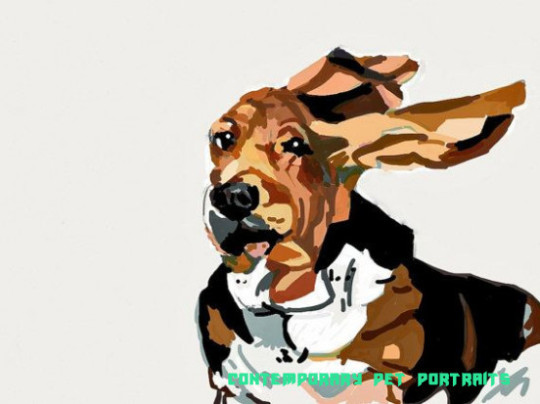
Pet Portrait Basset Hound Digital Download | Contemporary .. | contemporary pet portraits

Southern Pines, NC Artist – Jordan Baker – Custom Pet Portraits .. | contemporary pet portraits
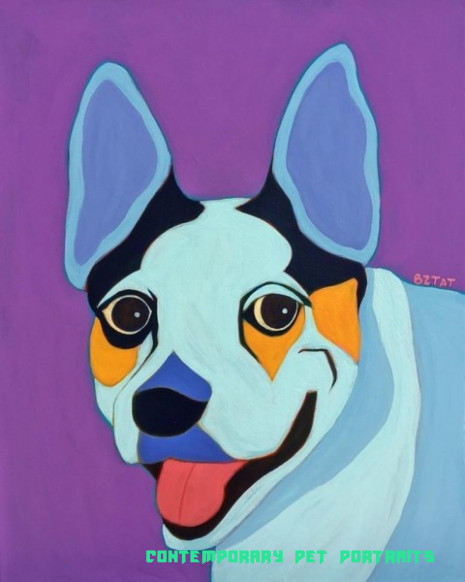
Premiere Contemporary Custom Pet Portrait Paintings .. | contemporary pet portraits

Premiere Contemporary Custom Pet Portrait Painting of a .. | contemporary pet portraits

Contemporary Digital Pet Portraits | BZTAT Studios – Pet .. | contemporary pet portraits

Contemporary Pet Portraits by Steve Javiel with Maddie and Jenna – contemporary pet portraits | contemporary pet portraits

Lizzie – contemporary pet portraits | contemporary pet portraits

Contemporary Pet Portraits – contemporary pet portraits | contemporary pet portraits
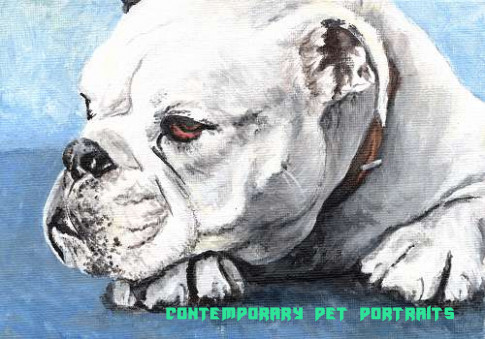
No Deposit Pet Portraits In Acrylic – contemporary pet portraits | contemporary pet portraits
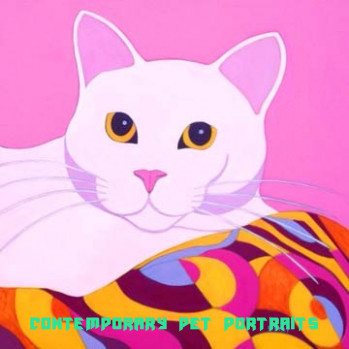
Premiere Contemporary Custom Pet Portrait Paintings .. | contemporary pet portraits
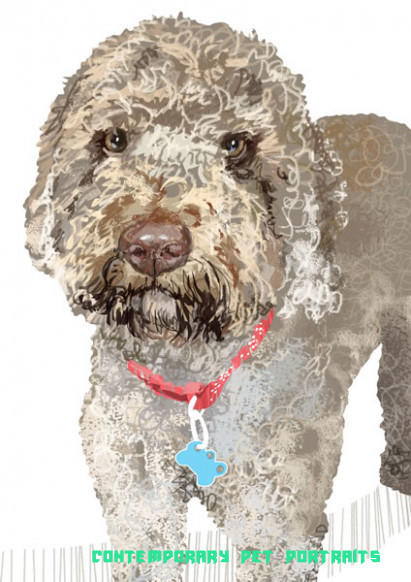
Contemporary Pet Portraits by Nick Oliver : gallery – contemporary pet portraits | contemporary pet portraits
The post This Is How Contemporary Pet Portraits Will Look Like In 12 Years Time | contemporary pet portraits appeared first on Wallpaper Painting.
from Wallpaper Painting https://www.bleumultimedia.com/this-is-how-contemporary-pet-portraits-will-look-like-in-12-years-time-contemporary-pet-portraits/
0 notes